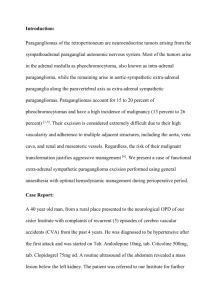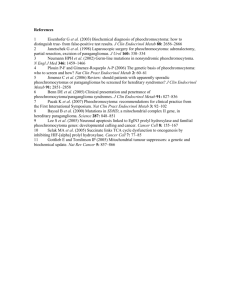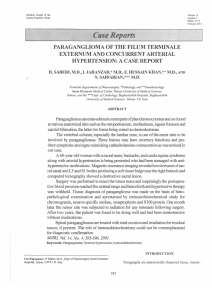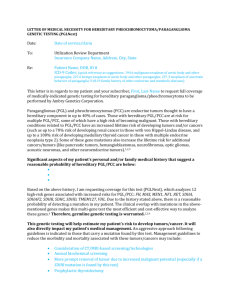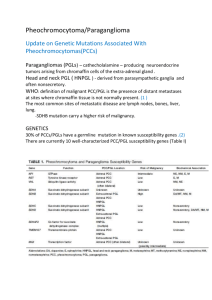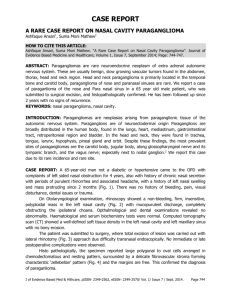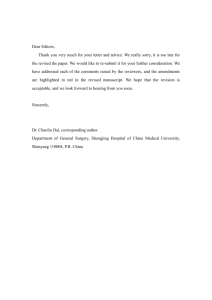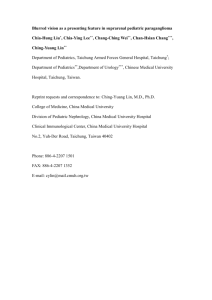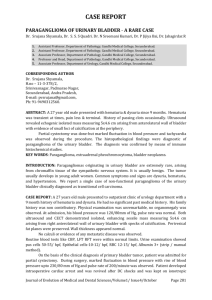Medicinski glasnik 36.indd
advertisement
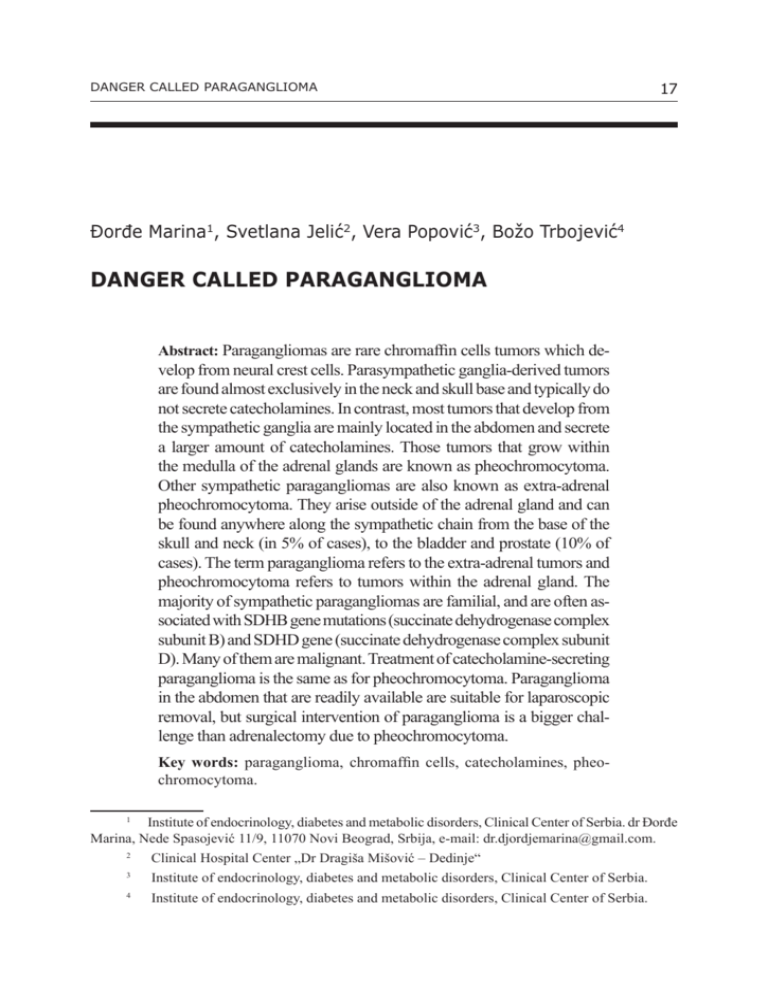
DANGER CALLED PARAGANGLIOMA 17 Đorđe Marina1, Svetlana Jelić2, Vera Popović3, Božo Trbojević4 DANGER CALLED PARAGANGLIOMA Abstract: Paragangliomas are rare chromaffin cells tumors which de- velop from neural crest cells. Parasympathetic ganglia-derived tumors are found almost exclusively in the neck and skull base and typically do not secrete catecholamines. In contrast, most tumors that develop from the sympathetic ganglia are mainly located in the abdomen and secrete a larger amount of catecholamines. Those tumors that grow within the medulla of the adrenal glands are known as pheochromocytoma. Other sympathetic paragangliomas are also known as extra-adrenal pheochromocytoma. They arise outside of the adrenal gland and can be found anywhere along the sympathetic chain from the base of the skull and neck (in 5% of cases), to the bladder and prostate (10% of cases). The term paraganglioma refers to the extra-adrenal tumors and pheochromocytoma refers to tumors within the adrenal gland. The majority of sympathetic paragangliomas are familial, and are often associated with SDHB gene mutations (succinate dehydrogenase complex subunit B) and SDHD gene (succinate dehydrogenase complex subunit D). Many of them are malignant. Treatment of catecholamine-secreting paraganglioma is the same as for pheochromocytoma. Paraganglioma in the abdomen that are readily available are suitable for laparoscopic removal, but surgical intervention of paraganglioma is a bigger challenge than adrenalectomy due to pheochromocytoma. Key words: paraganglioma, chromaffin cells, catecholamines, pheochromocytoma. Institute of endocrinology, diabetes and metabolic disorders, Clinical Center of Serbia. dr Đorđe Marina, Nede Spasojević 11/9, 11070 Novi Beograd, Srbija, e-mail: dr.djordjemarina@gmail.com. 1 2 Clinical Hospital Center „Dr Dragiša Mišović – Dedinje“ 3 Institute of endocrinology, diabetes and metabolic disorders, Clinical Center of Serbia. 4 Institute of endocrinology, diabetes and metabolic disorders, Clinical Center of Serbia. 18 MEDICINSKI GLASNIK / str. 17-26 The history of paraganglioma In 1743 Von Haller was first who described tissue of paraganglioma in carotid body, but it’s function remains unclear for decades. In 1862 and 1891 Von Luschka and Marchand in Europe were first to describe carotid body tumors. Scudder in the United States describes the removal of carotid body tumors in 1903. The anatomy experts described ganglions along the Jacobson nerve during the 1840, but the connection with paraganglioma was not established until 1941. Then in 1953 Guild described vascularised tissue on the curve of bulbus venae jugularis and promontorium of the middle ear, which he named glomus tissue (1). Nomenclature related to paraganglioma was not clear. Some authors indicate them as glomus tumors, hemodectomas, non-chromaffin tumors and tumors of the carotid body. Glenner and Grimely clarified this fact in 1947 as they divided the adrenal paragangliomas and named them pheochromocytomas and extra-adrenal tumors, which are further divided into branchiomeric, intravagale, aorticosympathetic and visceroautonomic. Branchiomeric paragangliomas are further divided into aortico-pulmonary, pulmonary and coronary, pointing to the fact that all of them are associated with arterial blood vessel and brachial plexus. In contrast, thoracal aorticosympathetic paragangliomas occur along the sympathetic chain and ganglia. Viscero-autonomic paragangliomas occur in visceral organs such as heart. Danger from the corner… Paraganglioma are chromaffin cell tumors that develop from the neural crest cells and may be divided into tumors derived from the parasympathetic or sympathetic ganglia. Although rare, these tumors constitute 10-18% of all chromaffin tumors (2-5). Parasympathetic ganglia-derived tumors are found almost exclusively in the skull base and in neck and occur within the carotid body and globe jugulotympanic. In a review of 236 patients with paraganglioma, Erickson and associates found that 69% of paraganglioma are located in head and neck region and most of them are parasympathetic in origin (2). The best known and most common tumors of sympathetic ganglia are pheochromocytomas located in adrenal glands. In contrast, sympathetic paragangliomas, also known as extra-adrenal pheochromocytomas, arise outside the adrenal gland and can be found all along the sympathetic chain and in the area of the skull base and neck (5% of cases), bladder and prostate (10% of cases). Of those found along the aorta, 10% are in thorax and 75% in the abdomen, and most of the others are located in the Zuckerkandl’s body, centered around the root of inferior mesenteric artery (3, 6). Presentation of paraganglioma is very variable, but the most important of all is early recognition and appropriate treatment of paraganglioma, which can reduce morbidity associated with symptomatic and malignant disease. DANGER CALLED PARAGANGLIOMA 19 Clinical presentation of paraganglioma Most of paragangliomas are diagnosed in the third to fifth decade of life (7). Clinical presentation depends on origin of paraganglioma, although there are some overlapping when it comes to sympathetic and parasympathetic paragangliomas. Paraganglioma may be presented in several ways: symptoms due to mass effect, symptoms of increased secretion of catecholamines and asymptomatic, accidentally discovered tumor (so-called incidentaloma). In the case of hereditary, familiar paragangliomas one should always think of the genetic screening of family members. Most paraganglioma (especially parasympathetic) are detected incidentally or due to compressive symptoms and the appearance of neck mass (known as “mass” effects) (2). In an era of increasing sophistication of imaging methods, 36-40% cases of pheochromocytoma and paraganglioma are presented as adrenal icidentaloma (2, 8). In large cohort studies the incidence of pheochromocytoma and paraganglioma in patients with incidentaloma was about 4% (9). Approximately 20-30% of patients with paraganglioma that is not localized in the neck will have symptoms of increased catecholamine secretion (2). Up to 50% of patients with thoracic paraganglioma will have hypersecretion of catecholamines (10). The most serious symptom of paraganglioma that can endanger life is hypersecretion of catecholamines. Most of catecholamine-secreting paragangliomas are located in the abdomen and pelvis, while only 3.6-4% of head and neck paraganglioma have enhanced production of catecholamines. The classic symptoms of increased secretion of catecholamines include: headache (26% of patients), palpitations (21% of patients), sweating (25%) and episodic hypertension (64%) (2, 6, 11). It should be known that only a third of patients have obvious symptoms of catecholamin excess. Other, less convincing symptoms of catecholamin excess are: hyperglycemia, panic attacks, fever, weight loss, myocardial infarction, osteolytic bone metastases, and Raynaud’s phenomenon. 50% of patients with bladder paraganglioma have triad of symptoms: intermittent hematuria and symptoms upon micturation or sexual activity (12). Most patients have some form of hypertension, with blood pressure elevations that are paroxysmal in 48% of patients and sustained in 29–50% (8, 13). Only 2-13% of patients are normotensive. An interesting fact is that the degree of hypertension is not correlated with the concentration of circulating catecholamines (14). Contrary to expectation, large tumors are more likely to be asymptomatic because the largest concentration of catecholamines are metabolized internally and then released in the form of byproducts like metanephrines and vanillylmandelic acid (VMA). Fortunately, in practice the small number of patients have “pheo crisis”, in which cases catecholamines can lead to extreme elevations in blood pressure and to heart attack, stroke, congestive heart failure, and even complete cardiovascular collapse. 20 MEDICINSKI GLASNIK / str. 17-26 Diagnosis Patients that should be screened for catecholamine-secreting tumors are: patients with classic symptoms, with labile hypertension, pregnant patient with new-onset hypertension, children with hypertension, patients with adrenal incidentaloma, positive family history for pheochromocytoma and certain genetic syndromes (MEN 2A, MEN 2b, Von Hippel-Lindau syndrome). The best screening test for catecholamin-secreting paragangliomas is the measurement of 24-h urine metanephrines concentration, with the control values of creatinine. This test has a sensitivity of 87-90% and imposes itself with good specificity of 99% or more (15, 16). In contrast, measuring plasma metanephrines has a high sensitivity of 96% but lower specificity of only 85% (15, 17, 18). The relatively lower sensitivity but very high specificity of urine metanephrines leads to fewer false positives results and therefore is generally the screening modality of choice. Because of its high sensitivity but low specificity, the determination of plasma metanephrines have unacceptably large number of false-positive results of 10-15% and therefore may not be adequate screening for catecholamines hypersecretion. False-positive results are more common in elderly. However, when there is a high pretest probability that the patient has a paraganglioma (i.e., patients with a personal or family history of pheochromocytoma or a genetic syndrome), the high sensitivity test reduces the chance that a patient with the disease will be missed. It is important to remember that few other diseases and medicaments can interfere with adequate determination of catecholamines: renal failure, increasing age, iodinated contrast agents (which reduce the concentration of metanephrines), stress, alcohol and some drugs (tricyclic antidepressants, levodopa, α-and β-blockers). However, switching from standard chromatography to fluorometric analysis, the number of false-positive results is significantly reduced due to drug therapy (such as α-methyldopa). It is interesting that patients who have a high concentration of noradrenaline in the urine and normal or slightly increased concentrations of adrenaline in the urine have a greater chance for the existence of paraganglioma because these peripheral tumors lack the enzyme phenylethanolamine-N-methyltransferase that allows conversion of noradrenaline into adrenaline. However, most patients with this biochemical profile will have pheochromocytoma. Elevation in urine or plasma metanephrine of greater than two times the baseline is diagnostic of paraganglioma, while elevation less than one times the baseline effectively rules out paraganglioma. The situation is more complicated in patients with borderline concentration of metanephrines (i.e. between one and two times the baseline). Some authors state their experience with patients who had adrenal incidentaloma and slightly increased values of metanephrines. In that series 30% of these patients with one to two times elevation in urine metanephrines had chromaffin tumor (19). As such, we recommend α-blockade or further diagnostic workup (i.e., MIBG scan or plasma metanephrines) for this group of patients. DANGER CALLED PARAGANGLIOMA 21 There are a number of other biochemical markers that are proposed as diagnostic tests for catecholamine-secreting tumors, but most of them are rejected. For example measuring the concentration of chromogranin A (a protein localized in secretory granules of neuroendocrine cells) has some advantages compared to the measurement of catecholamines, but the problem is the availability of measuring this marker in various Institutions, and also the sensitivity and specificity are 83% and 93% (20). Some doctors still use the provocative tests, but they should be used with great caution, since they can lead to a “pheo crisis” (21). Localizing paraganglioma Once the diagnosis of catecholamine excess is established, the next step is to localize a tumor. As already mentioned earlier, most of sympathetic paragangliomas are located in the area of abdominal sympathetic chain, particularly in the Zuckerkandl’s body near the beginning of the inferior mesenteric artery. However, paragangliomas can be found anywhere along the sympathetic chain from the skull to the bladder. It is recommended to do a detailed imaging of abdominal and pelvic regions. If this method does not localize the tumor, the one should do imaging of chest and neck area. There is no clear consensus on whether the localization of paraganglioma is better with magnetic resonance imaging (MRI) or computerized tomography (CT). Computerized tomography - CT recording with thin cuts of 2-5mm along with intravenous contrast has a sensitivity of 98% and specificity of 92% (22, 23, 24). Catecholamine-secreting tumors tend to have Hounsfield units in the 40–50 range. In order to determine possible existence of tumors in various places in the body, it is necessary to do imaging of the abdomen and pelvis. The main limitations of CT imaging is that it provides anatomic and not functional information and that it is subject to artifacts (the movement and the surgical clip). Although ionic contrast material has been reported to precipitate ‘‘pheo crisis,’’ studies have shown that nonionic contrast material does not cause ‘‘pheo crisis’’ and is therefore safe in evaluation for paragangliomas (25, 26). Magnetic resonance imaging - MRI can detect catecholamine-secreting tumors in 95% of cases and has a sensitivity of 93-100% (27, 28). The characteristic of paraganglioma is hyperintensity in T2-weighted sequences because of tumors hypervascularity. This characteristic brightness (which can also be seen in some cancer and metastasis) provides specific information to the examination. In pregnant women, children and patients with an iodine-based contrast allergy, MRI is the test of choice. However, besides these advantages, many clinicians prefer CT images because of better anatomical details. Metaiodobenzylguanidine scan (MIBG) - MIBG is selectively placed in the adrenergic vesicles, therefore it represents a good functional test for catecholamine- 22 MEDICINSKI GLASNIK / str. 17-26 secreting tumors. This test uses radioactive iodine so the patient’s thyroid gland must be blocked with potassium-iodide before giving contrast. MIBG is less sensitive to paraganglioma compared to pheochromocytoma, with the rate of false negative results up to 29% (2, 29, 30). The advantage of the MIBG scan is that it could indicate the existence of tumors in other parts of the body or the possible existence of metastasis. False negative results may occur due to asymmetric uptake in the adrenal gland that can mimic pheochromocytoma (31). Positron emission tomography - PET scan is based on the fact that the tumors use glucose in a much greater extent than healthy tissue due to its hypermetabolism. After administration of 18-fluorodeoxyglucose, “hot spots” on scanning indicate hypermetabolic tissue. Although this is a promising diagnostic tool, it’s limitations include lack of anatomical details and the fact that other tumors, such as cancer, are also PET positive (30). Currently, most clinicians use PET scanning not as a primary localization modality, but rather in cases of negative MIBG scans or rapidly growing tumors with a high metabolic rate (32). Treatment of paraganglioma Standard treatment of paraganglioma is complete surgical resection. Fortunately, most of paragangliomas are benign and with operable size (average size is 17.1cm3 for paragangliomas in head and neck and 94.1cm3 in other locations) (2). Preoperative preparation of the patient must be properly in order to avoid catastrophic consequences. Preoperative preparation Typically, main effect of catecholamine excess is α-mediated vasoconstriction. Severe and life-threatening hemodynamic changes can occur perioperatively from catecholamine surge due to tumor manipulation or complete cardiovascular collapse once this vasoconstriction is relieved after the tumor is removed. After tumor removal cardiovascular collapse may occur. That’s why in preparation for surgery the patient must use α-blockers at least 2 weeks before surgery in order to reduce vasoconstriction. During this time it is crucial to replete the patient’s intravascular volume, which is chronically decreased in these patients because of the ongoing vasoconstriction. It is also necessary to keep the patient on a moderate to high salt diet. The α-blockade should be continued until the patient is relatively normotensive and have mild symptoms (i.e., slight orthostasis). If the patient is constantly tachycardic after α-blockade one should think about the introduction of β-blockers. If it is started with the β-blockade before the α-blockade, this leads to α-mediated vasoconstriction, DANGER CALLED PARAGANGLIOMA 23 which can lead to “paradoxical hypertension”. Recently, some experts recommend the use of Ca-blockers, which lead to arterial vasodilatation and serve as an effective and reliable alternative to α-blockade. The advantage of Ca-blockers include fewer side effects, the absence of “overshoot hypotension” and the prevention of coronary arteries vasospasm. Surgical treatment of paraganglioma The best treatment of paraganglioma is surgical treatment. Type of surgery depends on the location and size of tumors. Cervical paraganglioma can be exscised through cervical incision. Localization of paraganglioma in the urinary bladder is almost always in trigone, which should take into account to protect or reimplant the ureters. Thoracic paraganglioma can be solved through a thoracoscopic or open approach. Abdominal paraganglioma, especially those near the adrenal gland or above that level, are best solved with transabdominal laparoscopic approach. Absolute indications for open resection involve local-regional invasion, high suspicion of malignancy or anatomic factors that could hinder laparoscopic approach. It should be noted that paragangliomas tend to have parasitic vessels. Unlike pheochromocytoma, paraganglioma usually have a large number of small arteries that come directly from the surrounding major arteries. For this reason, surgical resection of paraganglioma can carry the risk of profuse bleeding. However, these tumors rarely perform the invasion into large blood vessels, so they can be easily separated from the aorta and inferior vena cava. During the operation excellent cooperation between anesthesiologist and surgeon is required. With adequate preoperative preparation, patients should not experience the large variations in heart frequency and blood pressure. However, anesthesiologist should have short-acting vasoactive medications on hand in case of instability. It is important to use short-acting drugs because patients are susceptible to large variations in blood pressure and heart rate. Fluid boluses are the treatment of choice for hypotensive episodes. Treatment of malignant paraganglioma Patients with malignant and even certain forms of metastatic paraganglioma should undergo the removal procedure of greater part of tumor in order to reduce the metabolic consequences of catecholamine excess. Patients with unresectable or metastatic changes may undergo symptomatic treatment with α- and β-blockade. Some agents such as α-methyl-L-tyrosine inhibit the synthesis of catecholamines, which can to some extent lead to a reduction of symptoms. Finally, ablative dose of I-131 MIBG can be applied, although this process is still investigated and final opinion will be given only after a sufficient number of studies. 24 MEDICINSKI GLASNIK / str. 17-26 Monitoring and screening In order to confirm that all catecholamine-secreting tumors are removed from the body, it is necessary to do the analysis of metanephrines in 24-h urine or plasma sample 3-6 months after surgery. If the concentration is normalized, it is considered that the treatment is successful. If the concentration of catecholamines remain elevated, one should think about existence of additional tumors elsewhere in the body or occult metastases. Analysis of plasma or urinary metanephrines should be measured annually to determine recurrence, metastases, or the appearance of additional primary tumors. If concentrations are higher, you should repeat imaging of the body to localize tumors. Unlike pheochromocytoma that are malignant in 10% of cases, paraganglioma (particularly abdominal!) are malignant in 14% and up to 50% of cases, depending on the study. These malignant tumors tend to spread hematogenously, lymphatically, and through local invasion. Unfortunately, even final histopathological finding do not provide information about the degree of malignancy. The best indicator of the degree of malignancy is metastatic or recurrent tumor occurrence. For this reason in the postoperative period regular control of catecholamines with imaging methods is recommended. Approximately 25% of sympathetic-derived and 50% of parasympathetic-derived paragangliomas are inherited (33, 34, 35, 36). The younger patients are at the time of diagnosis, the greater possibility is for a hereditary disease. For example, in patients aged 10 years, the risk of hereditary disease is 70% while the risk gradually decreases until age 60 when the risk is effectively 0 (34). Most experts recommend genetic testing for all patients with paraganglioma. If the test detect genetic mutations, first-degree relatives should be screened for the same mutation. In addition to testing, patients should be offered the option of genetic counseling. REFERENCE 1. Myssiorek D. Head and Neck Paragangliomas. Otolaryngol Clinics N Am, 34:5 pp. 829836. 2. Erickson D, Kudva YC, Ebersold MJ et al. Benign paragangliomas: clinical presentation and treatment outcomes in 236 patients. J Clin Endocrinol Metab 2001; 86(11):5210– 5216. 3. Whalen RK, Althausen AF, Daniels GH. Extra-adrenal pheochromocytoma. J Urol 1992; 147(1):1–10. 4. Young WF Jr. Paragangliomas: clinical overview. Ann N Y Acad Sci 2006; 1073:21–29. 5. Elder EE, Elder G, Larsson C. Pheochromocytoma and functional paraganglioma syndrome: no longer the 10% tumor. J Surg Oncol 2005; 89(3):193–201. 6. Plouin PF, Gimenez-Roqueplo AP. Pheochromocytomas and secreting paragangliomas. Orphanet J Rare Dis 2006; 1(1):49. DANGER CALLED PARAGANGLIOMA 25 7. Sclafani LM, Woodruff JM, Brennan MF. Extraadrenal retroperitoneal paragangliomas: natural history and response to treatment. Surgery 1990; 108(6):1124–1129; discussion 9–30. 8. Gifford RW Jr, Manger WM, Bravo EL. Pheochromocytoma. Endocrinol Metab Clin North Am 1994; 23(2):387–404. 9. Mantero F, Albiger N. A comprehensive approach to adrenal incidentalomas. Arq Bras Endocrinol Metabol 2004; 48(5):583–591. 10. Ogawa J, Inoue H, Koide S et al. Functioning paraganglioma in the posterior mediastinum. Ann Thorac Surg 1982; 33(5):507–510. 11. Plouin PF, Duclos JM, Menard J et al. Biochemical tests for diagnosis of phaeochromocytoma: urinary versus plasma determinations. Br Med J (Clin Res Ed) 1981; 282(6267):853–854. 12. Leestma JE, Price EB Jr. Paraganglioma of the urinary bladder. Cancer 1971; 28(4):1063– 1073. 13. Bravo EL, Tagle R. Pheochromocytoma: state-of-the-art and future prospects. Endocr Rev 2003; 24(4):539–553. 14. Bravo EL, Tarazi RC, Gifford RW et al. Circulating and urinary catecholamines in pheochromocytoma. Diagnostic and pathophysiologic implications. N Engl J Med 1979; 301(13):682–686. 15. Kudva YC, Sawka AM, Young WF Jr. Clinical review 164: The laboratory diagnosis of adrenal pheochromocytoma: the Mayo Clinic experience. J Clin Endocrinol Metab 2003; 88(10):4533–4539. 16. Sawka AM, Jaeschke R, Singh RJ et al. A comparison of biochemical tests for pheochromocytoma: measurement of fractionated plasma metanephrines compared with the combination of 24-hour urinary metanephrines and catecholamines. J Clin Endocrinol Metab 2003; 88(2):553–558. 17. Lenders JW, Eisenhofer G, Armando I et al. Determination of metanephrines in plasma by liquid chromatography with electrochemical detection. Clin Chem 1993; 9(1):97– 103. 18. Lenders JW, Keiser HR, Goldstein DS et al. Plasma metanephrines in the diagnosis of pheochromocytoma. Ann Intern Med 1995; 123(2):101–109. 19. Lee JA Zarnegar R, Shen WT et al. Adrenal incidentaloma, borderline elevations of urine or plasma metanephrines and the ‘‘subclinical’’ pheochromocytoma. Arch Surg 2007; 142(9):870-873; discussion 73-74. 20. Hsiao RJ, Parmer RJ, Takiyyuddin MA et al. Chromogranin A storage and secretion: sensitivity and specificity for the diagnosis of pheochromocytoma. Medicine 1991; 70(1):33–45. 21. Young WF Jr. Phaeochromocytoma: how to catch a moonbeam in your hand. Eur J Endocrinol 1997; 136(1):28–29. 22. Manger WM, Eisenhofer G. Pheochromocytoma: diagnosis and management update. Curr Hypertens Rep 2004; 6(6):477–484. 23. Pacak K, Eisenhofer G, Ilias I. Diagnostic imaging of pheochromocytoma. Front Horm Res 2004; 31:107–120. 26 MEDICINSKI GLASNIK / str. 17-26 24. Quint LE, Glazer GM, Francis IR et al. Pheochromocytoma and paraganglioma: comparison of MR imaging with CT and I-131 MIBG scintigraphy. Radiology 1987; 165(1):89–93. 25. Bessell-Browne R, O’Malley ME. CT of pheochromocytoma and paraganglioma: risk of adverse events with i.v. administration of nonionic contrast material. AJR Am J Roentgenol 2007; 188(4):970–974. 26. Mukherjee JJ, Peppercorn PD, Reznek RH et al. Pheochromocytoma: effect of nonionic contrast medium in CT on circulating catecholamine levels. Radiology 1997; 202(1):227–231. 27. Francis IR, Korobkin M. Pheochromocytoma. Radiol Clin North Am 1996; 4(6):1101– 1112. 28. Honigschnabl S, Gallo S, Niederle B et al. How accurate is MR imaging in characterisation of adrenal masses: update of a long-term study. Eur J Radiol 2002; 41(2):113–122. 29. Timmers HJ, Kozupa A, Chen CC et al. Superiority of fluorodeoxyglucose positron emission tomography to other functional imaging techniques in the evaluation of metastatic SDHB-associated pheochromocytoma and paraganglioma. J Clin Oncol 2007; 25(16):2262–2269. 30. Ilias I, Pacak K. Current approaches and recommended algorithm for the diagnostic localization of pheochromocytoma. J Clin Endocrinol Metab 2004; 89(2):479–491. 31. Elgazzar AH, Gelfand MJ, Washburn LC et al. I-123 MIBG scintigraphy in adults. A report of clinical experience. Clin Nucl Med 1995; 20(2):147–152. 32. Pacak K, Eisenhofer G, Ahlman H et al. Pheochromocytoma: recommendations for clinical practice from the First International Symposium, October 2005. Nat Clin Pract Endocrinol Metab 2007; 3(2):92–102. 33. Grufferman S, Gillman MW, Pasternak LR et al. Familial carotid body tumors: case report and epidemiologic review. Cancer 1980; 46(9):2116–2122. 34. Amar L, Bertherat J, Baudin E et al. Genetic testing in pheochromocytoma or functional paraganglioma. J Clin Oncol 2005; 23(34):8812–8818. 35. Neumann HP, Bausch B, McWhinney SR et al. Germline mutations in nonsyndromic pheochromocytoma. N Engl J Med 2002; 346(19):1459–1466. 36. Neumann HP, Pawlu C, Peczkowska M et al. Distinct clinical features of paraganglioma syndromes associated with SDHB and SDHD gene mutations. JAMA 2004; 292(8):943–951.
